
We’re about to glide through Nicoyan waters. Saying this, more than one will think that we’re going to Samara or Garza beach to go sport fishing or to take a boat tour, but no. Here’s another clue: we’re going to spend the day on a little piece of land surrounded by water. Now many people will bet we’re talking about Isla Chora, but that’s not it either.
Instead, we drive 45 minutes in the opposite direction from the waters of Guanacaste’s oceanside. We leave behind towns, pastures and hills until we reach Pozo de Agua lagoon.
A few hundred meters from the town center, this mirror of water surrounds El Tieso Ecological Center. That’s the name that local farmers called the mounds of earth that protrude from the wetlands, where the cattle go up to sleep after grazing.
This “tieso” (meaning stiff or rigid) in the middle of a lagoon has a large rancho-style pavilion that has been benefiting families from the community for a few months now, with a great combo: rural tourism, water sports, bird watching and traditional Guanacastecan food.
To get to this kind of artificial island, we have to leave the car on the muddy shore lined with water lilies. As we walk towards the boat we’ll be going in, we meet Juan Pablo Montes, a community resident who takes time off from his job on the cattle ranch on weekends to become the captain of this very small boat, in which he has taken up to 15 people.
Juan Pablo is 62 years old, skinny and his sinewy arms propel the boat with a long pole, like the gondoliers of Venice. A motorboat would scare away any animal that might be nearby.
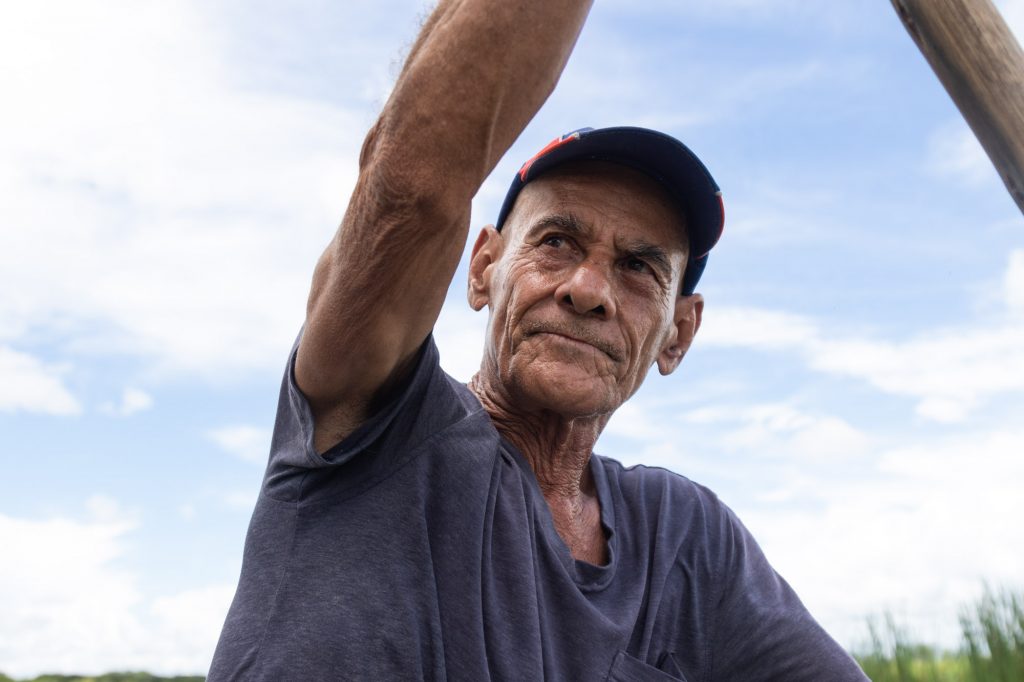
Juan Pablo Montes is a 62-year-old rancher. On weekends, he becomes the captain of this little boat. “I’m here because I like it. For me, this isn’t a job,” he comments.Photo: César Arroyo Castro
The few sounds we hear come from the movement of the water with each stroke, the wind blowing in the opposite direction and the flapping of a heron’s wings as it flies away through the wetlands.
If a bit of stress has built up during the week, the first few strokes through the lagoon dissolve it. The five-minute trip to the small island is therapy in itself, not just for us, but also for Juan Pablo.
Things are going well for me in cattle ranching, but I’m here because I like it. For me, this isn’t a job,” he tells us.
As soon as we set foot on El Tieso, we are greeted with a pipián stew with Guanacastecan tortillas and a glass of cold pozol, a pujagua (purple corn) drink sweetened with tapa de dulce (crude sugar). This delicious welcome was prepared by Hania Medina, Xiomara Obando and Margoth Matarrita.
They are part of the Pozo de Agua Lagoon Association and also Las Mujeres del Maíz (The Women of Corn), a group of women from towns such as Puerto Humo, Moracia, Corralillo and Nicoya, who prepare traditional meals based on the local corn produced by small farmers from the communities.
The pavilion and this mound, as we see them today, haven’t existed for very long. Even the lagoon that surrounds it disappeared at some point and the community had to recover it.
A Plague and an Opportunity
As Hania recalls, it all started during the summer of 2015, when they experienced the worst plague of mosquitoes.
That year, a problem from which the Corral de Piedra Marshy Wetland had been suffering got worse. The area has several lagoons, including Pozo de Agua.
These lagoons have been drying up because the estuaries have filled with bushes and sediments that prevent the tides from the Tempisque River from flowing to the lagoons and wetlands.
The tour is an opportunity to do rural tourism in the community of Bolsón
The small amount of water that managed to enter became stagnant and created the perfect ecosystem for mosquitoes to lay eggs.
You couldn’t live here at night or during the day. It was something terrible. Even the animals died. So we formed a group and decided to clean the lagoon,” Hania remembers.
That same stormy year in 2015, a brigade of men and women volunteered from the community and organized themselves to use machetes to chop and clean the estuaries of the plants that blocked the flow of water.
The mosquito crisis didn’t stop completely, and it worsened again in the middle of 2020, when everyone was confined to their homes due to the COVID-19 pandemic. That time, though, they were able to take different actions because the National System of Conservation Areas (Spanish acronym: SINAC) updated the management plan, allowing them to do so.
So they were able to get approval to intervene in the lagoon with machinery from the Municipality of Nicoya and that way, clean it of sediments.
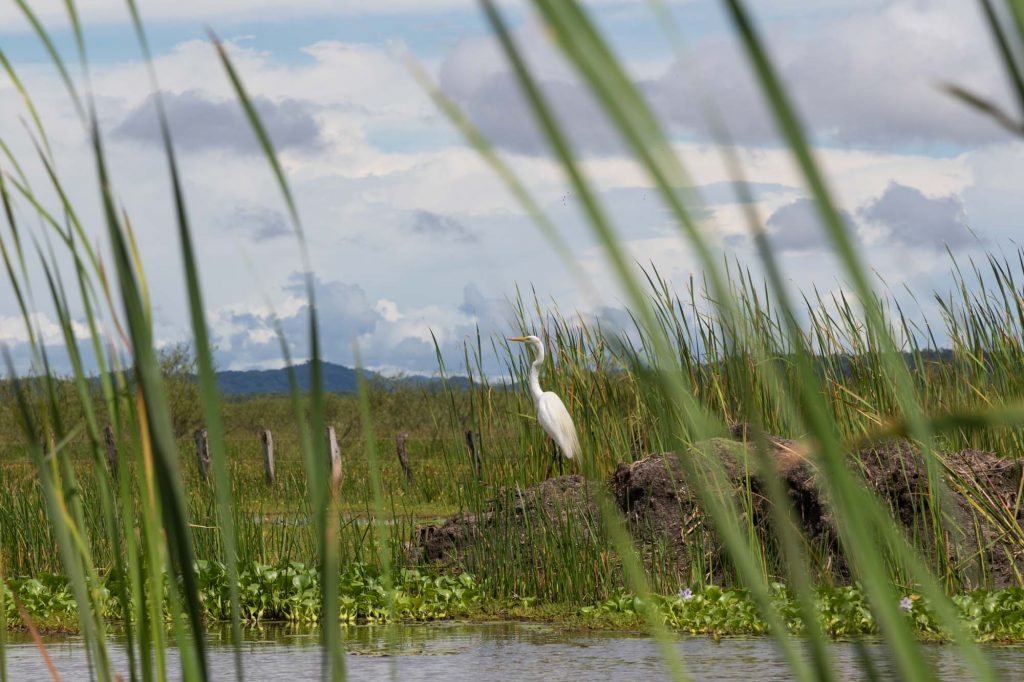
The Pozo de Agua Association along with other State institutions, such as the Ministry of Labor and Social Security (Spanish acronym: MTSS), the Rural Development Institute (Spanish acronym: INDER) and SINAC, joined forces to restore the lagoon and the wetland while eliminating the plague of mosquitoes, but they also thought about how they could take better advantage of this ecosystem.
As the mountain of earth accumulated, another great idea also grew: to use the material to create a mound right where the previous one once was.
That mound ended up being 2,000 square meters (half an acre) and has its own pavilion, and people can reach it by boat every month of the year, even when the rainy season ends.
At this time, the association plans to build floodgates that will allow water from the Tempisque River to circulate through the lagoon during the dry season.
In this way, they will continue to guarantee profits, 70% of which currently go to the association’s women and the remaining 30% go to conservation of the lagoon (clerning out invasive plants, planting trees, habitat studies, etc.).
A Perfect Combo
Before continuing with the task of eating everything these ladies put in front of us, we decide to take a ride on the pedal boat and take one of the four kayaks available to explore the lagoon.
For some reason, the weather smiles upon us, a refreshing wind clears away the enormous clouds loaded with water and pushes them far away. A veil of rain begins to obscure all of the hills that surround us: Corral de Piedra, Sonzapote and Caballito.
The only little mountains that it leaves in clear view are the most photographed of all: the Rosario hills, which have the silhouette of a huge woman lying down. During the short walk, we were able to see some white herons and ducks in the wetland. Juan Pablo told us that during the dry season, seeing roseate spoonbills, tiger herons and jabiru storks is common.
Hunger strikes, and after half an hour of pedaling, we return to the island. On shore, a couple of tourists take photos and videos of “the sleeping woman” who stretches across the horizon.
Christian Madrigal and Andrea Quesada came from Curridabat to climb Caballito hill at dawn and watch the sunrise. When they reached the top, they discovered the mirrors of water that surround the Tempisque River and asked how to get there.
I love this because it creates a connection with people and I’m going to take with me the memory of this body of water in the middle of the Guanacaste savannah,” says Christian.
Andrea confesses that she wouldn’t have this type of experience if she had decided to vacation at a beach hotel this weekend.
“I know that the work situation is difficult here. You see people making an effort and you say, ‘it’s worth being part of that assistance,’” adds Andrea.
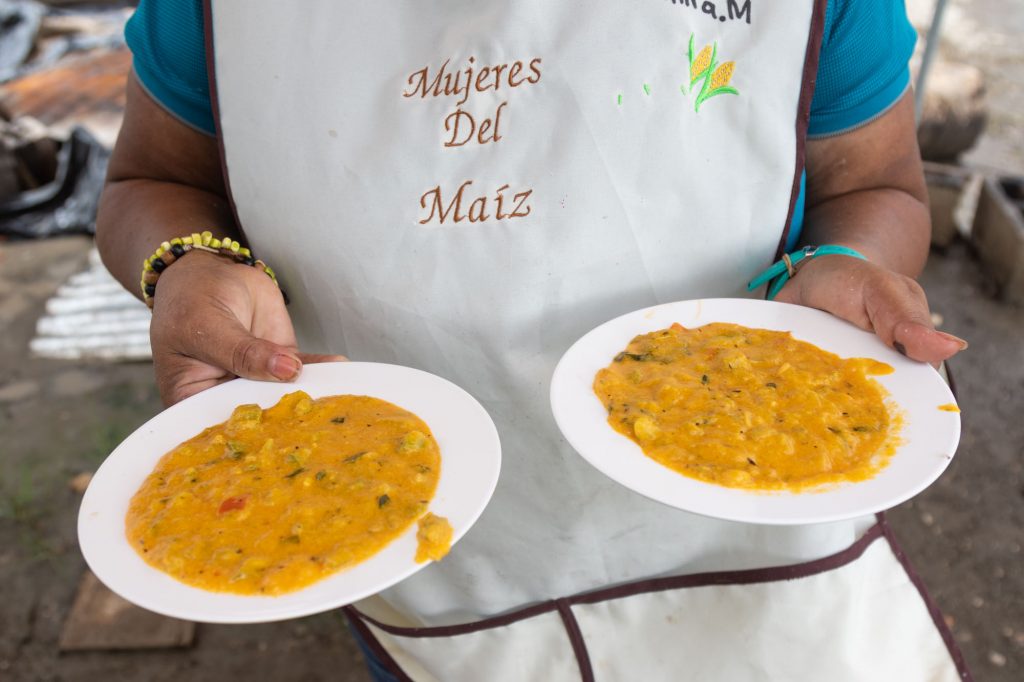
Several members of the Women’s Corn Association are responsible for preparing their “ancestral foods” for tourists, such as atol (a thick corn-based beverage), pozol (a purple corn drink sweetened with crude sugar) and achiote chicken.Photo: César Arroyo Castro
Aside from this couple, there are few people visiting the lagoon on the Saturday we decided to visit. Hania assures us that Sunday is the day when the most people visit, but although the pavilion has capacity for 70 people, they haven’t yet filled it.
On the way back to the pavilion, we meet another person who set off today in search of a peaceful day: the mayor of Nicoya, Carlos Armando Martinez.
It generates a new awakening for me that there is a more responsible and experiential type of tourism in the community; that there is a compensation, that is, enjoying what you’re doing, but you know that you’re helping families, entire communities,” says the mayor.
The mayor adds that what he most admires is that the need to find a solution to the plague made it possible to come up with this idea and unite the neighbors to build the project by cooperating.
A few more steps ahead of us, the entrepreneurs move in a choreography of plates loaded with refried beans, achiote chicken, salad and tortillas that start on the burners and end up on our table.
Hania and the other cooks treat us like someone else from the town. Juan Pablo converses at the table next to us as if he were our neighbor. They even bring us little gourds filled with pujagua corn atole (a thick corn-based beverage), in case there was any doubt that this is the closest thing to a family lunch.
Despite the tempting offer to stay for coffee with a roasted tamale, we decided to make the return trip with Juan Pablo. Although there would be nothing wrong with staying and continuing to eat until we burst, ending up with our bodies lying here staring up, like the sleeping woman who keeps an eye on the sky in Pozo de Agua.
Back in the boat, Juan Pablo begins to talk and puts it another way: “I was born here right next to it. I’m never going to move away from the lagoon,” says the captain, casting his contagious promise to the wind.
Do you want to go to Pozo de Agua Lagoon?
Here’s all you need to know:
- Only open on weekends
- You have to make a reservation by phone: 8644-2844
- Not accessible for people with reduced mobility
- Suitable for people of all ages
- Parking: Yes
- Pets: Yes
- What to bring?: sunscreen and insect repellent
- You can find them on Waze and their Facebook page as Laguna de Pozo de Agua Pueblo Místico
- Price*: Full-day package is ¢12,000 (about $19), which includes breakfast, snack, lunch, purple corn atole for dessert, coffee with roasted tamale and use of a kayak or pedal boat
*If you don’t want the full-day package, you can choose each of the services separately.


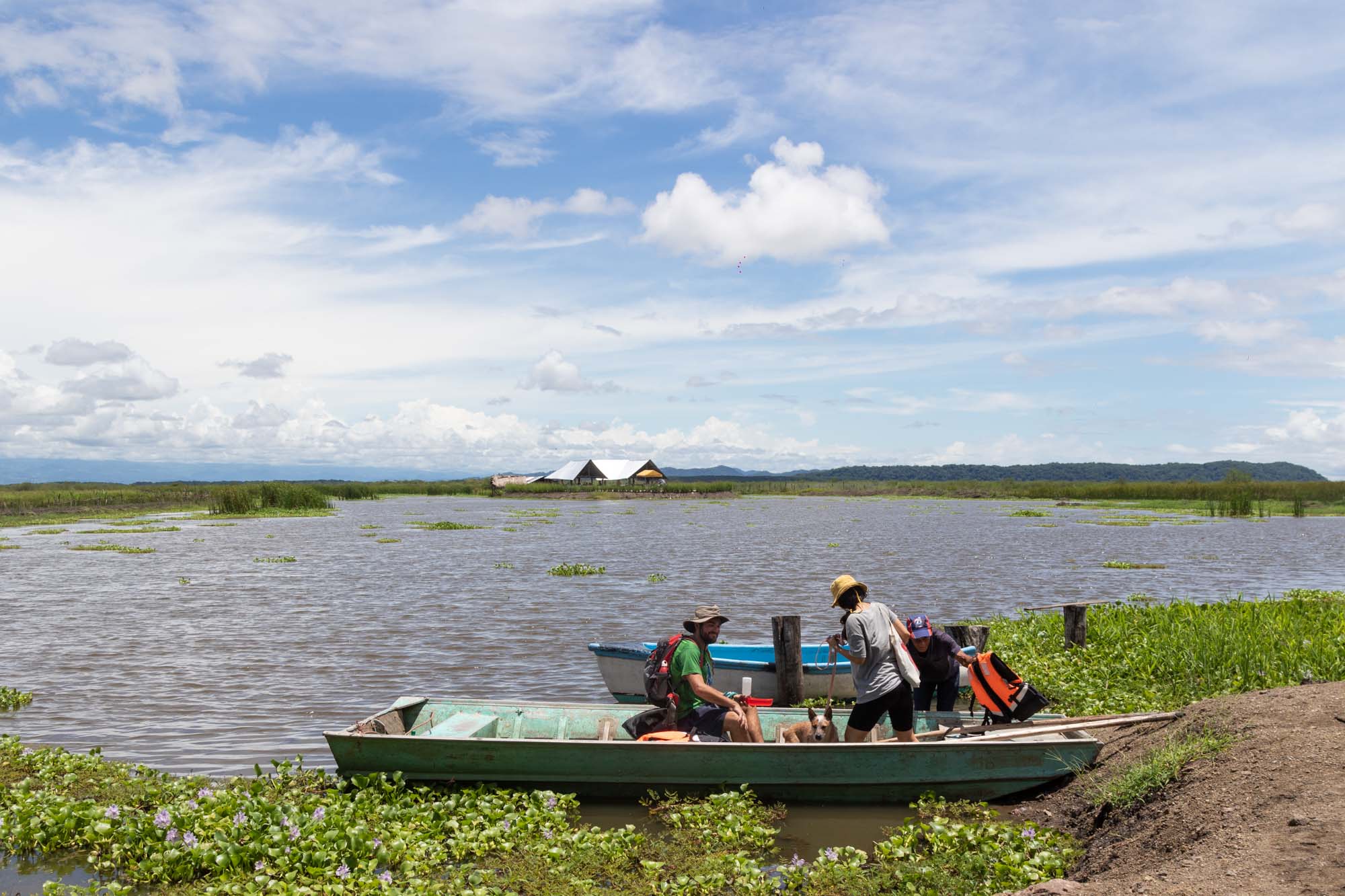
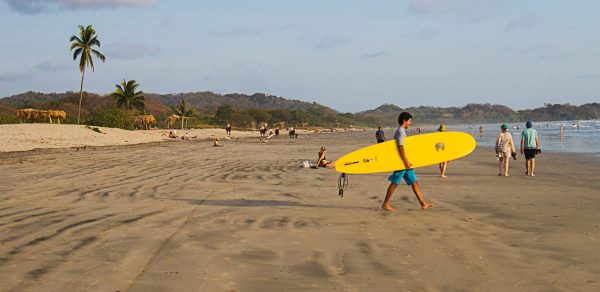
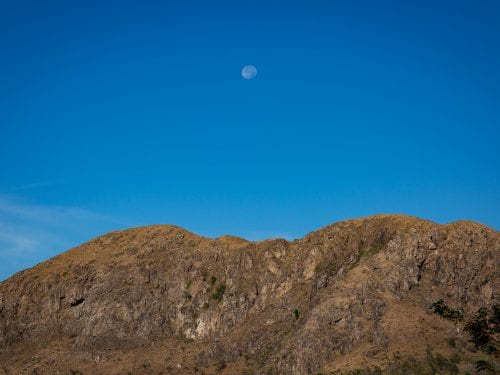
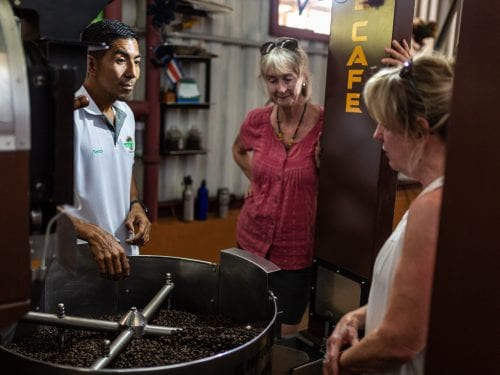

Comments